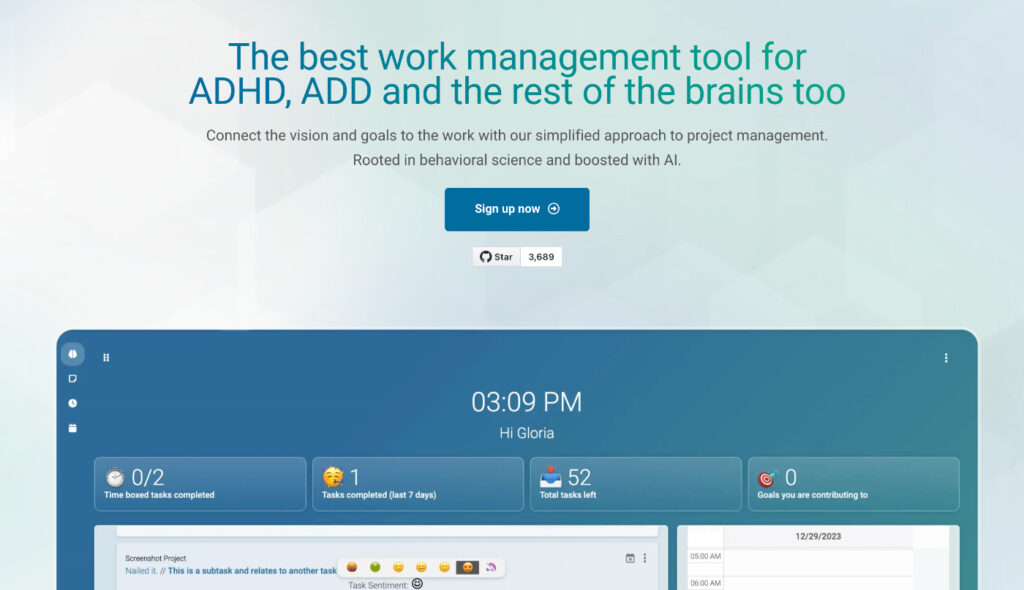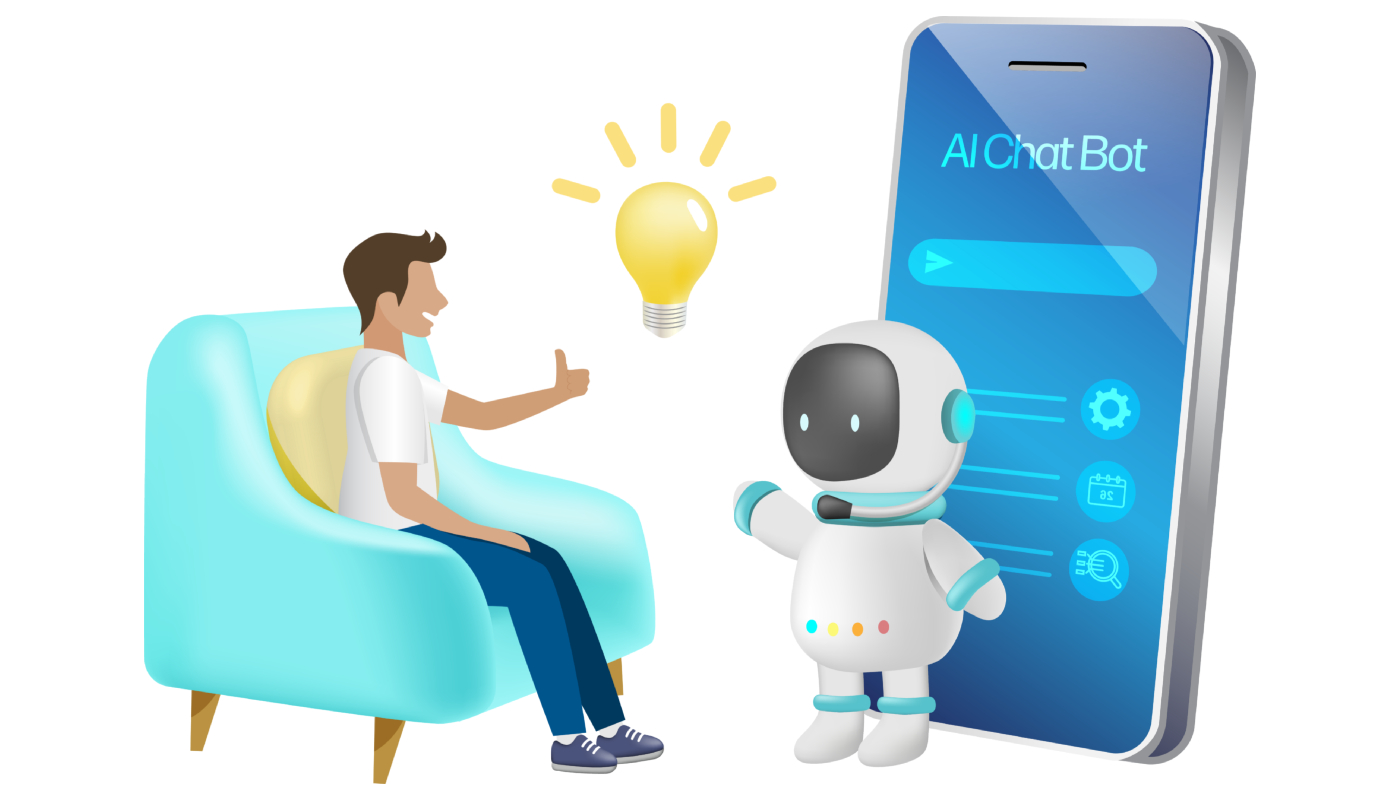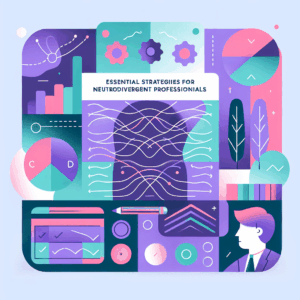Estimated reading time: 12 minutes
Artificial intelligence has drastically changed how we work, boosting productivity, automating manual tasks, and streamlining business operations. But its use case also expands to helping people manage ADHD.
In this article, I’ll dive into how AI is changing how we manage ADHD symptoms at work. I’ll also discuss how adults with ADHD can use AI productivity tools to improve their work and give some tips on how to use these tools to boost work performance.
Table of contents
What is Attention Deficit Hyperactivity Disorder (ADHD)?
Attention Deficit Hyperactivity Disorder (ADHD) is a neurodevelopmental disorder characterized mostly by persistent inattention, hyperactivity, and impulsivity patterns. It impacts individuals across various domains and all parts of life.
Read More: Best Project Management Tool for Neurodiverse Teams
ADHD can extend well into people’s adult life, affecting how they handle daily tasks, personal activities, and work. ADHD could make completing tasks more challenging. Project management and virtual meetings can also become more difficult.
For example, ADHD in tech companies could present unique challenges for individuals working on complex development projects and adhering to strict deadlines.
In management roles, it could cause problems with focus on projects, leading to missing out on important tasks.
Read More: Project Management Tools for ADHD
However, having ADHD isn’t all that bad. ADHD individuals can also possess strengths in areas like creativity, out-of-the-box thinking, and adaptability, which also bring a lot of great benefits for the individual and the organization.
Companies can also benefit greatly culture-wise from fostering a supportive environment that understands the diverse needs of their workforce, including those with ADHD.
ADHD Symptoms
If you want to learn how to manage symptoms of your ADHD, you need to know what symptoms ADHD adults might have.
What are the most common ADHD symptoms, and how they might manifest? Here are the most common ones:
Inattention
- Difficulty sustaining attention in tasks or activities.
- Making careless mistakes at work.
- Difficulty organizing tasks and deliverables.
- Avoiding tasks that require sustained mental effort.
- Frequently losing items like your cell phone, keys, materials, or supplies.
- Being easily distracted by external stimuli.
- Forgetfulness in daily activities.
Hyperactivity
- Fidgeting or squirming when seated.
- Difficulty staying seated when expected to.
- Running or climbing excessively when inappropriate.
- Difficulty engaging in activities quietly.
- Often “on the go” or acting as if “driven by a motor.”
- Talking excessively.
Impulsivity
- Blurting out answers before someone completes a question.
- Difficulty waiting for one’s turn.
- Interrupting or intruding on others’ conversations or activities.
Read More: How to Get Work Done with ADHD
Using ADHD Tools
When learning how to deal with ADHD, tools come in very handy. Thankfully, there are now many ADHD apps that help with task management. Pairing these tools with the best ADHD coping skills will help you remain productive.
Best Productivity Tools for ADHD
There are many productivity apps available to help people who struggle with managing their ADHD. Here are the most helpful ones we’ve found.
1. Leantime

Leantime is a work management app built for employees with ADHD. It provides workers with ADHD with a full suite of features that help them stay productive while managing different aspects of their work.
Read More: How to Be More Productive: 24 Innovative Tips for Success
Some of the features of the software include the following:
- Idea and strategy management boards
- Project management boards with a choice of kanban, table, or list views
- Distraction-free to-do lists to stay organized
- Time blocking and time tracking features
- Goal dependency and reporting
- A calendar layout to view and set reminders daily
- And many more
Did You Know: Time blocking is a time management technique that involves dividing your day into blocks of time.
Their AI features are set to release soon, including AI Story Time, AI Status Update, Status Reports, and AI Coach. Leantime’s AI is a represented by a little robot named L.E.O — short for Leantime Enhanced Outcomes. You can read more about the ADHD features.
Read More: Feedback at Work: Rejection Sensitivity Dysphoria and ADHD
While other apps focus on project and work management for the general public, Leantime emphasizes helping those with ADHD. By doing this, they hope to promote greater inclusion in the workplace.
2. Forest App
Forest is a mobile app and browser extension that brings a gamified approach to help users stay focused and avoid distractions.
When you set a timer to work on a task, a virtual tree will grow during that time. If you leave the app or get distracted, the tree dies. Users enjoy the sense of accomplishment and the visual representation of their focus time.
This productivity app is great for motivating people with ADHD. If you’re looking for a fun activity while managing time, Forest App is a great solution.
3. Brain.fm
Brain.fm is an AI-powered music app that improves focus, relaxation, and sleep. Brain.fm uses scientifically engineered audio tracks to enhance specific brainwave patterns, unlike regular background music.
Sometimes, relying on random music played on YouTube and Spotify can cause more distractions. Brain.fm takes out that problem from the equation by masterfully curating your tracks so you can focus on getting work done, making it an efficient productivity tool for some individuals.
Users with ADHD will likely find these tracks helpful for entering a focused and productive state during work or study sessions.
4. RescueTime
RescueTime is a productivity tool that runs in the background on your devices and tracks how you spend your time. This fully automated time-tracking software is great for watching where your time goes.
There are many great time-tracking project management apps available. But what I like about RescueTime is that it provides detailed reports on your daily activities, such as time spent on different apps and websites.
Rescue Time has a smart system that analyzes your focus and meeting schedules daily. It then uses that data to give insights and nudges to help you stay on track. It also analyzes and blocks the sites that harm your focus the most.
Using this app is great for analyzing your digital behavior. This way, anyone with ADHD can identify time-wasting habits and improve their time management.
5. Google Calendar
Google Calendar is a widely used software tool that can be extremely helpful for individuals with ADHD in managing their time, schedules, and commitments.
Google Calendar offers an intuitive interface to input and organize their schedule. Most recently, Google has also integrated with its AI-powered voice assistant to make calendar management even more seamless for its users.
Users can set specific dates, times, and reminders for each event or task, helping them stay on top of their commitments making it a great calendar app.
What Adult ADHD Looks Like
ADHD in children is a common talking point when discussing this mental state. However, an estimated 10 million adults have ADHD, [1] which should spark conversations about what ADHD looks like among adults, especially at work.
Many adults with ADHD face challenges in their personal and professional lives, and the disorder can significantly impact their overall functioning and development.
ADHD in adults also often occurs alongside other disorders such as anxiety, depression, bipolar disorder, or substance use disorder. This isn’t always the case, but the presence of heightened risks can be of concern.
Over time, ADHD symptoms can evolve. For instance, hyperactivity might often decrease as you become older. Some symptoms, like attention problems, can persist into adulthood and even grow if one doesn’t address them.
People in the workplace, especially leaders, should recognize these signs and encourage proper treatment. Untreated ADHD can severely affect a person’s personal and professional life.
Fortunately, ADHD is a condition that most, if not all, can manage well. Combination treatment involving medication and psychotherapy are great way to relieve symptoms of ADHD. There are also many tools to help manage them.
To manage ADHD well, it’s highly important to seek qualified professionals to accurately diagnose and differentiate ADHD from other potential causes or co-existing conditions.
If you suspect you have adult ADHD or have members in your team who might have it, talk to a doctor about getting an adult ADHD evaluation. Early diagnosis and appropriate treatment can make a significant difference.
How ADHD Impacts Productivity
How might ADHD affect an adult productivity-wise? Here are common productivity issues that come with ADHD:
Difficulty Staying Focused and Attentive
People with ADHD often struggle to maintain their focus on tasks for extended periods. They may also get distracted easily by irrelevant stimuli like background noise, conversing staff, and so on.
Procrastination
Due to difficulties with initiating tasks and sustaining motivation, individuals with ADHD may procrastinate. ADHD procrastination can also cause a delay in starting important assignments or responsibilities.
Time Management Challenges
ADHD time management challenges are quite prevalent. This can make it hard to estimate how long certain to-do lists or tasks might take. As a result, some people with ADHD might have poor time management skills.
Sometimes, people with ADHD will run late, miss deadlines, or struggle to complete multiple tasks within a set timeframe; having to do lists can be beneficial.
Organization Problems
People with ADHD often struggle with organizing their physical space, as well as their thoughts and ideas.
Forgetfulness
Memory problems are common in individuals with ADHD. It can become challenging to remember appointments, deadlines, or important details.
Hyperfocus
Although attention difficulties are typical in ADHD, some individuals can also experience episodes of hyperfocus, where they become intensely absorbed in a particular task or activity.
Impulsivity
Impulsivity can lead to hasty decisions and actions without considering potential consequences. This can result in errors or wasted time and effort.
Restlessness and Discomfort with Repetitive Tasks
The restlessness associated with ADHD can make engaging in repetitive or monotonous tasks difficult.
Emotional Dysregulation
Emotional sensitivity and self-esteem challenges are common among individuals with ADHD, affecting their focus and confidence.
Lack of Interest or Boredom
People with ADHD may have difficulty at work maintaining interest in certain tasks. On these occasions, you might have reduced productivity in activities you see as unstimulating.
Achieving Productivity with ADHD
While it might be more difficult for some people with ADHD to stay productive, it is far from impossible. Here are some ways to achieve greater productivity when you have ADHD.
Set Clear and Realistic Goals
Seeing the bigger picture with projects might be difficult. Break down your tasks into smaller, manageable steps, and set specific, achievable goals. Don’t forget to celebrate each accomplishment so that you stay motivated.
Use Visual Reminders
It helps greatly to have a to-do list that you can visually see. Use sticky notes, calendars, or digital task management tools to represent tasks and deadlines visually. Keep all your reminders in a visible place.
Prioritize Tasks
Sometimes a to do list helps you know what larger tasks should have more weight to you. So, identify the most important tasks and start with those first. Focusing on high-priority items first can help prevent feeling overwhelmed.
Create a Routine
Establishing a daily routine will make you feel more structured at work. This can also help reduce decision-making stress so you’re at optimal best at work. Keep consistent routines so you can transition between activities easily.
Minimize Distractions
When possible, set up a distraction-free space. Create a command center with all your work-related ADHD organization tools and items.
Turn off notifications on electronic devices, and consider using noise-cancelling headphones.
Break Tasks into Time Increments
Divide them into shorter intervals for longer or tedious tasks with breaks in between. Put a time limit on those tasks to motivate you to finish them. This approach can make tasks more manageable and reduce restlessness.
Practice Mindfulness and Meditation
Regular mindfulness and meditation exercises help improve focus and attention, reduce impulsivity, and increase ADHD productivity. Find a program that works for you and stick to a fixed schedule.
If you’re determined to learn how to manage ADHD without medication, mindfulness could be a great way to maintain focus and attention in the long term.
What is AI and How Can It Benefit People with ADHD?
Integrating these innovative tools can empower ADHD individuals to manage their workflow better and enhance their performance.
There are some advantages to being an ADHD company. Some organizations may focus on creating an inclusive work environment that addresses the needs of employees with ADHD.
You can provide flexible work hours, implement productivity techniques like the Pomodoro method, and promote the use of ADHD tools to aid focus on smaller tasks and time management.
Doing this supports your ADHD employees and fosters a culture of acceptance and understanding.
AI ADHD Assistant
To accommodate individuals with ADHD, tech companies can explore the concept of ADHD AI, using the power of AI to create an ADHD assistant for adults with ADHD.
Such AI applications could include:
- Task managers that provide personalized reminders.
- Smart scheduling systems for optimizing productivity for ADHD users.
- AI-driven focus tools to reduce distractions and improve attention during work or study sessions.
Final Thoughts
There are many ways to provide ADHD help for adults, but AI tools are bringing us to new frontiers. So, it only makes sense to start using these tools or other tools that could help you improve your work.
With these five tools and my many tips, you should find new and effective ways to address focus, distractions, hyperactivity, and impulsivity challenges. Which tools are you planning to use?
Remember, your ADHD will only hinder you if you don’t manage it well. Focus on ways you can maximize the advantages they bring and minimize the disadvantages. Doing that can make you more productive and competitive at work.
If you’re managing team members with ADHD, giving them the support they need could boost workplace productivity, morale, and inclusivity.
Resource:
[1] CHADD. (2018). Overview – CHADD. CHADD. https://chadd.org/for-adults/overview/






